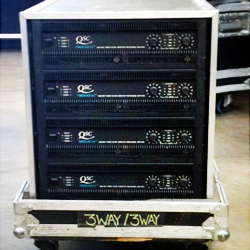Editor’s Note: This article was originally published in the March/April 2000 issue of Live Sound International, and it still provides a wealth of valuable information on this important topic.
Q.) What does a power amplifier do, anyway?
A.) In a nutshell, a power amp takes your audio signal and provides both voltage gain and current gain to drive loudspeakers. The voltage gain is necessary because line-level audio runs around a volt, peaking at maybe 8 to 12V, and loudspeakers need more voltage than that to produce usable sound levels.
Voltage gain is determined by the amp’s circuitry and the position of its attenuators or gain controls; it is typically expressed as a mathematical multiplier, such as “40x,” or in decibels, such as “32 dB” (which is equivalent to 40x, by the way).
In an amp with a gain of 40x, 0.25V in will produce 10V out, 1V in will produce 40V out, and so on, up until the output reaches the amp’s clipping point. A considerate amp manufacturer will tell you either on the front or rear panels or somewhere in the user’s manual what the amp’s full gain actually is.
The current gain is necessary because compared to the amp’s input, loudspeakers are very-low-impedance devices. You can think of impedance as the ratio of the voltage across a device to the amount of current it allows through. Therefore, the lower its impedance, the more current a device will allow to flow when you put a certain voltage across it.
An amp input might typically have an impedance of 10, 15, or 20 kilohms, which means that for a line-level signal, the input will draw minuscule amounts of current. That’s why crossovers, mixers, and other devices we use to drive amp inputs don’t have to put out much power.
But loudspeakers have to do lots of work, pushing and pulling air to create sound. They draw current because current, or electron flow, is useful. Electrons flowing through the speaker’s voice coil make the magnetic fields that react with the speaker’s magnet to push the cone or diaphragm in and out. Basically, current allows the loudspeakers to do serious work. Thus, an amp has to have plenty of current capacity, although how much it puts out depends entirely on the output signal voltage and the load impedance.
With no load connected, meaning a load impedance of infinity, the amp will produce voltage but no current. With an 8-ohm load, the amp will produce practically the same voltage and will put out current. With a 4-ohm load, the amp will again produce the same voltage and put out twice as much current as at 8 ohms, and so on (assuming you’re always running below the clipping point).
That’s what an amp does. How it does it will be explained in other answers. So read on.















